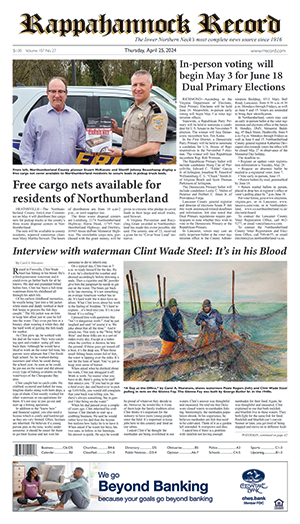
by Henry Lane Hull
[dropcap]D[/dropcap]uring the First World War when the federal government took the land in King George County to become the Naval Proving Ground, now the Naval Surface Warfare Center, many local traditions passed into history. Residents of the area were displaced, and in their stead came the installation of a large military complex, named for the Civil War Admiral John A. Dahlgren.
From the vantage point jutting out into the Potomac River, the Navy was able to test weaponry over a span of 20 miles. I recall as a child being out in our boat on the river when a naval vessel came along alerting us to move towards shore as a test firing was about to take place.
Our next-door neighbors at the beach were Clarence and Florence Osterman. He worked at the local icehouse, which was built about 1900 to provide a means of refrigeration for perishable goods. Each morning the residents of cottages still without electricity went to the icehouse to get their daily block of ice to bring back to their oak or chestnut iceboxes to keep food cold for the rest of the day.
In his free time C. Osterman liked to fish in the river, hauling his nets to catch his supper and to sell the extra. One day in his net he pulled up an unexploded shell from one of the Dahlgren test firings. He brought it home and instead of alerting the Proving Ground that he had it, he decided to dismantle it to make a lamp for his wife. He took it to the icehouse where he had access to a blow torch and a power drill.
Bernard Denson, known to all as Boozie, who later served a number of terms as the mayor of Colonial Beach, had returned from the war to operate his parents’ grocery store on Bancroft Avenue, about three blocks from the icehouse. One day he went to the icehouse to retrieve some of his perishable goods to take to sell at his store and found Clarence working on the shell. The icehouse served local merchants as well as the public for the temporary storage of items that needed to be kept cold.
Boozie was interested in what Clarence was doing with the shell and he stayed for a while, watching him work. As he headed back to his store, he heard an enormous explosion. Clarence had detonated the shell, resulting in his own death and the ruin of the icehouse, which later was rebuilt in a smaller footprint, but at a time when home refrigeration was becoming affordable due to the extension of power lines throughout the town. The business never recovered.
Florence continued to live in her cottage for another 15 years before moving to Fredericksburg where she took employment in a bakery. Two years ago, her former home, one of the most distinctive Victorian cottages on Bancroft Avenue, was lost in a fire.
Boozie, who had an illustrious military career during the war, surviving enemy fire and wounding, might have lost his life at the icehouse had he remained watching the dismantling any longer. He went on to become mayor in 1958, serving several separate terms and returning to the town council shortly before he died in 1980.
His legacy continues today as his son, Rocky, retired from the insurance business to open a new Denson’s Market, not in the same location as the original, but carrying on the family tradition of offering great food, to go or to eat on the premises, a few blocks away from the old stand.
The explosion that Clarence Osterman literally triggered changed life at the beach forever, ending the summer cottage mentality and escorting in a new age of permanent residents, symbolized by the transition from iceboxes to refrigerators.











